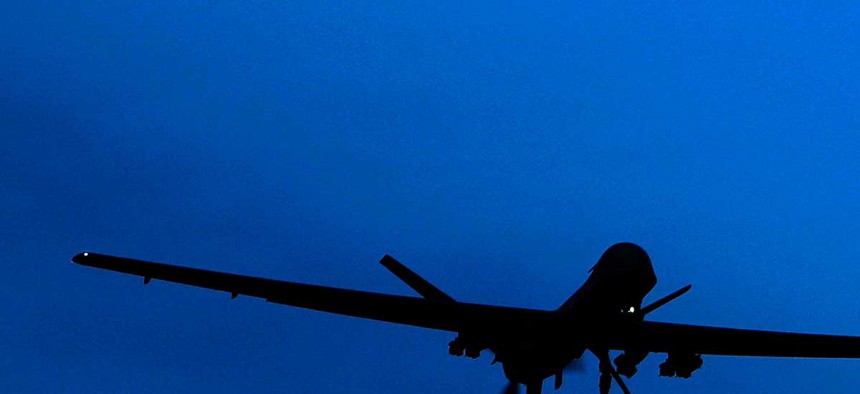Now You Can Track U.S. Drone Killings on an App
A new iPhone app will buzz your pocket each time the United States kills someone with a drone. By Robinson Meyer
On Monday, the new publication First Look reported that electronically obtained metadata controls who, how, and when U.S. drones kill abroad. Journalists Glenn Greenwald and Jeremy Scahill write that that kind of information doesn’t only determine who is killed: Metadata on phone SIM cards determines how victims of the strikes are found.
“The drone program amounts to little more than death by unreliable metadata,” they write, paraphrasing an ex-drone operator.
Now, a new iPhone app lets you explore the consequences of that phenomenon. Named—fittingly—Metadata+, it catalogues and maps drone killings by the United States and is now free and available for download .
The app was made by data artist and web developer Josh Begley. Its two views variously mirror iOS’s Messages interface, displaying the date, location, and victims of each killing; it also shows a map of U.S. drone strikes across the Middle East and Somalia.
Most strikingly, Metadata+ will send users an in-app notification whenever there’s a new strike.
The app, in other words, places an experience foreign to many Americans in a context they’re familiar with: their smartphone. It isn’t the first project do so. Begley’s own @dronestream Twitter account , followed by more than 27,000 people, tweets about every new strike, interrupting their friends’ chatter with more violent news. And London-based artist James Bridle has led two similar efforts, operating an Instagram feed that posts satellite imagery of every strike’s location and painting the shadow of drones on the ground in major Western cities.
Each project tries to transplant the anxiety of those who live below drones to the everyday experience of those very distant from them.

I wrote to Begley to ask about the design decisions behind the app. I was interested in how he balanced the obtrusive—the violent content of the app—and the unobtrusive—its reliance on iOS design. He wrote back:
When I started making the Drones+ app, its core question was about interruption (Would anyone actually want these alerts? Do we want to be as connected to our foreign policy as we are to out smartphones?)
Now, it’s become more about the historical archive. How do you represent information about people you'll never know—which is effectively metadata gleaned from English-language news reports—in a way that is intuitive and chewable but also unsettling?
For me, borrowing the visual vernacular of Apple's expertly built interface opens up the potential for a different kind of seeing. If the folks on the other side of our missiles are presented to us in the same places we see pictures of our loved ones (James Bridle’s dronestagram ) or communicate with our friends ( @dronestream ), might that nudge me to learn a little more about the contours of covert war?
I love my phone because it puts me at the center of the map. But I'm not the center of the map. I can't even pronounce the names of the places we're bombing. As much as I'm interested in apps that are ephemeral, I'm interested in apps that teach me something.
As reported by Mashable , Begley submitted his app five times before it was finally accepted. App Store representatives didn’t accept Metadata+ when it was named “Drones+,” nor when it displayed any information about drones.
“If it's going to be about that specifically, it’s not going to be approved," an employee reportedly told Begley. “But if you broaden your topic, then we can take another look.”
Begley finally submitted Metadata+ as an app without content—so the app itself said nothing about drones. The app would eventually, he said, display “real-time updates on national security” and download its content—the information and location of each strike—from the web after being launched for the first time.
This time, Begley found success. Metadata+ was accepted in five days.
“The artist Paul Miller (aka DJ Spooky) had an interesting exhibition called The Imaginary App,” Begley said in an email, explaining where he got the idea to submit a contentless news application:
It asked: ‘What is the most desirable, terrifying, smart, ridiculous, or necessary app that has not been and, possibly, will never be released?’
The idea of an app without content stemmed from Paul's call for submissions. Having been rejected on the grounds that a news aggregation app contained ‘excessively objectionable or crude content,’ I was curious to see where the content line was. The idea for the drone-tracking app was always about posing a question though.
The ironic part is that most reports about drone strikes are themselves non-content. Beyond the number of people who were reported killed, the province in which it took place, and the anonymous official who is certain these folks were 'militants,' there's not much there. Hence a project to compile all the metadata. (The double meaning, of course, as Esquire's Tom Junod has noted , is that metadata is the basis on which a 'signature strike' is carried out.)
Begley says he’s next thinking about developing an ephemeral app. “When Steve Jobs announced the iPhone, one of the things he said is that the problem with phones [of that period was,] ‘They all have these control buttons that are fixed in plastic. They’re the same for every application,’” he said.
“So,” Begley asked, “what if you made an app that was designed to change? Like Snapchat, its content fades away and it becomes something else in 6 months. The act of opening a Snap is exciting to me because I'm not sure what it will be. Might you open an app more frequently if the only thing you know is that you're not sure what it will contain?”





